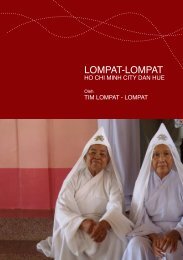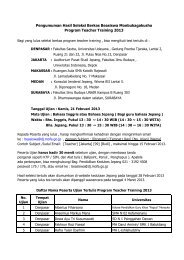9700_y16_sy
9700_y16_sy
9700_y16_sy
You also want an ePaper? Increase the reach of your titles
YUMPU automatically turns print PDFs into web optimized ePapers that Google loves.
Cambridge International AS and A Level Biology <strong>9700</strong> <strong>sy</strong>llabus Other information<br />
Learning outcomes removed from the <strong>sy</strong>llabus content<br />
The following learning outcomes have been removed from the 2015 version of the <strong>sy</strong>llabus.<br />
A Level only learning outcomes are indicated in bold type.<br />
G (i) outline the roles of nitrate ions and of magnesium ions in plants<br />
H (h) explain how tobacco smoking contributes to atherosclerosis and coronary heart disease (CHD)<br />
(i) evaluate the epidemiological and experimental evidence linking cigarette smoking to disease<br />
and early death<br />
(j) discuss the difficulties in achieving a balance between preventions and cure with reference to<br />
coronary heart disease, coronary by-pass surgery and heart transplant surgery<br />
K (a) define the terms habitat, niche, population, community and eco<strong>sy</strong>stem and be able to<br />
recognise examples of each<br />
(b) explain the terms autotroph, heterotroph, producer, consumer and trophic level in the context<br />
of food chains and food webs<br />
(c) explain how energy losses occur along food chains and discuss the efficiency of energy<br />
transfer between trophic levels<br />
(d) describe how nitrogen is cycled within an eco<strong>sy</strong>stem, including the roles of nitrogen-fixing<br />
bacteria (e.g. Rhizobium) and nitrifying bacteria (Nitrosomonas and Nitrobacter)<br />
N (b) define the term excretion and explain the importance of removing nitrogenous waste<br />
products and carbon dioxide from the body<br />
(l) explain what is meant by the term endocrine gland<br />
(m) [PA] describe the cellular structure of an islet of Langerhans from the pancreas and<br />
outline the role of the pancreas as an endocrine gland<br />
(o) outline the need for, and the nature of, communication <strong>sy</strong>stems within flowering plants<br />
to respond to changes in the internal and external environment<br />
Q (d) describe the reasons why one named species has become endangered, and use this<br />
information in the context of other endangered species<br />
R (b) explain the advantages of treating diabetics with human insulin produced by gene<br />
technology<br />
S (a) outline the use of microorganisms in the extraction of heavy metals from low grade ores<br />
(b) explain what is meant by the terms batch culture and continuous culture<br />
(c) compare the advantages and disadvantages of batch and continuous culture with<br />
reference to the production of secondary metabolites (e.g. penicillin), enzymes<br />
(e.g. protease) and biomass (e.g. mycoprotein)<br />
T (a) [PA] describe and explain the structural features of a named, wind-pollinated plant<br />
(b) compare the outcomes of self-pollination and cross-pollination in terms of genetic<br />
variation<br />
(c) [PA] describe the structure of the fruit in maize and explain the function of the<br />
endosperm<br />
(d) explain the significance of the grains of cereal crops in the human diet<br />
U (a) [PA] describe the histology of the mammalian ovary and testis<br />
(e) discuss and evaluate the biological, social and ethical implications of the use of<br />
contraception<br />
78 www.cie.org.uk/alevel Back to contents page





